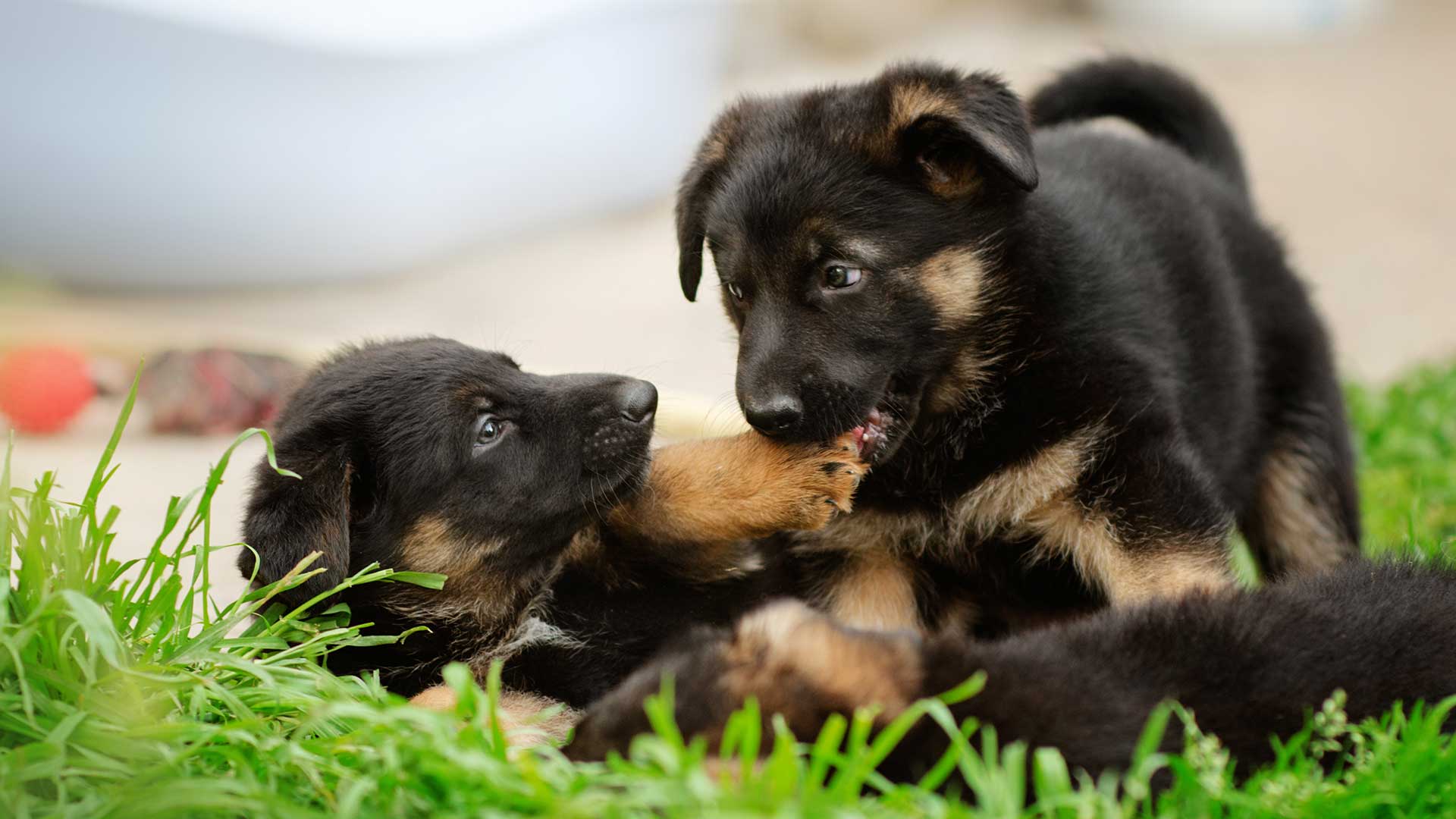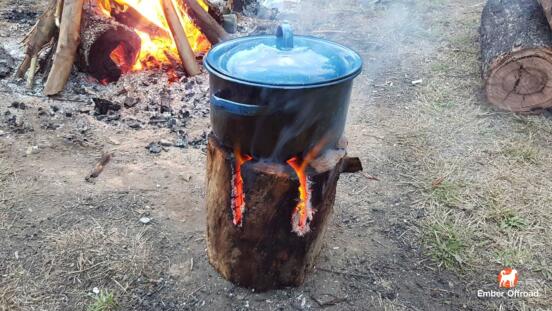
I travel everywhere with my dogs; country and city, from campfire cooking in the forest to dog-friendly bars in town, so they need to be comfortable in these environments and with my varied lifestyle.
So, you’re standing in front of a litter of puppies; They’re all cute, probably excited, and jumping all over you which only makes choosing harder, and you could easily pick up any of them and walk away with a puppy in your hands and a smile on your face.
How do you choose?
At 8 to 12 weeks old you can’t predict exactly what kind of dog a puppy will become. Still, there are a few things to look out for when selecting your pup to improve your chances of them growing into a well-adjusted, friendly, and easily manageable companion.
Health
When buying from a breeder you have the added advantage of viewing the dam and sire to see what the puppies will grow into. Registered breeders will have all the usual paperwork, and in breeds where certain health problems are commonplace, there will be information on how likely the line is to be affected by them, e.g. joint health ratings for breeds susceptible to dysplasia.
If adopting from a shelter this information won’t be available, even if a dog does appear to be a pure breed it won’t have been dropped off along with a stack of informational paperwork by a reputable breeder. It might look 100% but you can’t really know for sure.
The majority of puppies you find there will be crossbreeds. While lineage and health paperwork from a breeder can be nice to have, cross-breeding itself has some inherent health advantages. It’s not a guarantee, and crossbreeds can still have issues related to their pure halves, but in general, they will have a lower risk of congenital health problems and if afflicted the problem will be less pronounced. In best instances though, crossbreeds have “all their strengths, none of their weaknesses”.
Whatever the history of the puppy you’re looking at, the general things to look out for are the same:
- Eyes should be clear and bright with no discharge or crusting.
- The nose should also have no discharge or crusting, and the puppy should breathe quietly. Labored breathing or regular coughing or sneezing can indicate a problem.
- The coat should be attractive and healthy, not greasy, and without excessive dandruff.
- Test hearing by performing a soft clap behind the puppy to see if they turn, or have someone behind the puppy get their attention by sound only.
- Eyesight can be similarly tested by having them follow a moving finger or slowly rolling ball.
- As the expression says, they should have some puppy fat. Feel around the rib cage to make sure they have a little extra padding there.
- Puppies will rotate through a sleep, play, sleep, play routine half a dozen times every day so timing counts here; A well-rested puppy should be energetic and alert so try to catch them at the right time to observe this.
- Look for any obvious signs of physical distress when running, like limping or a strange gait.

Temperament
As with health, buying from a breeder has its advantages when it comes to temperament. A lineage of calm, sociable dogs means puppies who are more likely to grow into similarly calm and sociable adults. With pups of unknown origins, it’s a little bit more of a gamble.
It’s important to note here that all dogs are individuals. Puppies with the best beginnings and heritage can still grow to have problems later, others who have terrible starts to life through abuse or neglect can be wonderful dogs. As always, your best bet is early socializing and training, both are a must for every puppy.
You can’t predict future behavior perfectly but there are some good, and not-so-good, signs to look for.
Interactions with other puppies/dogs
- When puppies are wrestling during play look for puppies who will swap positions and are happy being on the top and bottom, this is ideal. Always being on the bottom is also Ok and indicates a more submissive personality. Avoid puppies that refuse to be on the bottom and growl if they lose their top position.
- Look for puppies who understand when to stop playing. If another puppy yelps or snaps at them does the one you’re looking at stop immediately or keep wrestling until broken up? Likewise, if the play partner disengages by walking away to stop playing, does the puppy you’re looking at let them go or leap on them from behind? You want a puppy who responds appropriately and will stop when told they’re being too rough or that the other dog no longer wants to play.
- Look for puppies who are sociable but not afraid to stand alone. Puppies who constantly stand apart from the pack and refuse to play may be less sociable in the future, those who can’t go two seconds by themselves may be very needy.
- In a nutshell, you want a puppy who can happily start and respond to interactions in a balanced fashion. They should ideally be willing to approach other dogs but not be over-excited, and should be calm and relaxed when approached by other dogs; a little bit of caution is fine, but they shouldn’t show signs of being genuinely fearful or defensive.

Interactions with people
Much of what is outlined above translates to how the puppy should interact with people as well. When approaching a litter or individual puppy stand a few feet away and observe the following:
- A puppy should be willing/eager to approach you but not overly excited. After a few minutes of sitting with the puppy, the initial excitement should have passed for them, if you stand to leave they should let you go or calmly follow. Avoid puppies that endlessly leap at you and never quite seem to calm down.
- A little trepidation is ok (they are small and the whole world is new to them after all) but puppies should not be fearful when you approach.
- Your potential puppy should be happy to be touched all over. You should be able to scratch their neck, run your hand the length of their back, rub their belly, stroke their legs, scratch their chin etc. Also gently restrain the puppy for a minute and see how they react. Puppies who are comfortable being touched are less likely to react defensively in later-life situations like being held for veterinary examination or being patted by strangers.
Choosing an overly excited puppy deserves a special mention here as this is (in my experience) the most common pitfall. Don’t get me wrong, I understand the appeal, sitting down in a pen and having a dozen charging puppies wash over me brings a smile to my face every time, but that’s only for 20 minutes.
Do you want to live with the same intense excitement every morning when you get up, every mealtime, every time you get home, every time you stand up from the couch, at 11:00 pm when you want to go to bed, at 3:00 am in the morning when you get up to go to the bathroom and it takes 45 minutes to calm your dog down again… Probably not. Find a park with a few owners of 3-month-old puppies and you’re sure to see a few tired faces.
If possible also try to observe the puppies playing with toys and eating to see if there is any guarding behavior, and ask the breeder/shelter about it.
Puppies who growl, who become rigid and pin toys to the ground when someone approaches, and who won’t share are likely to exhibit the same guarding behavior as adults.
The same goes for food. In addition to growling and defensive body language, scoffing down food as fast as possible (to stop anyone else from getting to it first) is also a sign that food guarding could develop. Ideally, your puppy should eat at a semi-relaxed pace, they may leave the bowl before it’s empty and return to it later, you should be able to remove and replace the bowl without protest. If another puppy can stick its face in the bowl at the same time without any reaction, that’s even better.
You can’t put your puppy to the test in every possible scenario before making your choice, and different behaviors can develop as your puppy matures into an adult, but looking for the above is a good start to get things off on the right foot.
# Choosing a puppy. How to choose a puppy. Which puppy do I choose?






